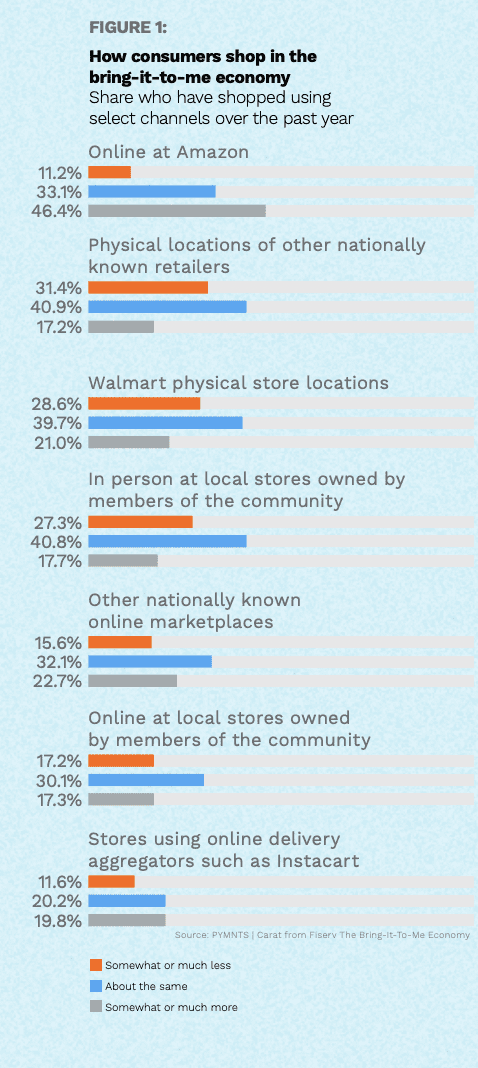For many people and companies, there exists a burning desire to move past the global pandemic and return to some semblance of “normal,” which most take to mean a resumption of life as it was approximately two years ago.
But for retailers, a return to 2019 after nearly two dozen months of upheaval and challenges would likely be a disaster. For one, physical retail was on its last legs as consumers cut back on trips in favor of digital shopping, and legacy merchants were struggling to make the shift to eCommerce. The starkest evidence of this came after the onset of the pandemic, as 2020 saw at least 30 retail companies file for bankruptcy.
Read Karen Webster’s column: Why the Physical Store Model Is Dead
But perhaps more importantly, retailers have given shoppers a whole new box of tools, such as contactless payments and curbside pickup, that connected consumers are unlikely to put down. And even if foot traffic levels rebound at stores, customers are now looking for a different type of experience than what was offered prior to COVID-19 entering the lexicon.
The Permanent Digital Shift
PYMNTS’ Connected Economy research has found that 92% of consumers have placed an online order for a product or service at least once recently, and one in 10 do so multiple times per day. Additionally, 84% of shoppers have checked online for discounts or sales, and 77% have contacted a merchant online in the last 12 months.
Advertisement: Scroll to Continue
And this holiday shopping season — the first one in which stores are reopened with limited or no pandemic restrictions — 87% of consumers plan to do at least some of their holiday shopping online, 10 percentage points higher than last year.
Related news: Holiday Shopping Outlook Suggests ‘Amazon Christmas’ May Be Underway
A Changed Mindset
Similarly, digital marketplaces have seen an influx of traffic, with 94% of consumers having made a purchase on an online marketplace and 52% having made a retail purchase using an aggregator such as Instacart in the last year. Nine in 10 consumers have shopped on Amazon in the last 12 months, for example, and 70% have made a purchase on at least one other nationally recognized digital marketplace.
The widespread use of these platforms has changed consumers’ outlooks and expectations for retail purchases, creating a “bring-it-to-me” mindset that drives purchasing decisions and impacts how shoppers want to engage with brick-and-mortar retailers. For example, 44% say that in-store pickup options would encourage them to make purchases from physical retailers, and 42% say curbside pickup options would do the same.
 Read more: New Study: Bring-It-to-Me Economy Ascends as Consumers Embrace Home-Centric Lifestyles
Read more: New Study: Bring-It-to-Me Economy Ascends as Consumers Embrace Home-Centric Lifestyles
The New Shopping Schedule
Additionally, as physical and digital shopping worlds collide, consumers are increasingly making decisions about whether to shop in-store or online — based not on product availability, but rather on what their schedule allows and when they need an item.
PYMNTS research, conducted in collaboration with Carat from Fiserv, found that 50% of all consumers have increased their “buy now, get later” (BNGL) shopping behaviors in the past year, opting to shop online and have their purchases delivered. Clothing and accessories have seen the biggest shift, with 17% of all consumers buying more of their apparel via BNGL than they did last year.
Also see: COVID Taught Consumers That 2-Day Delivery Tops Instant Gratification
Payment Preferences
Even for the four in 10 consumers who are making more “buy now, get now” purchases than before the pandemic, payment preferences have shifted because of health concerns raised by the pandemic. One-third of consumers say that acceptance of contactless cards would encourage them to shop more at physical stores, including 38% of Generation Z, and 25% say that acceptance of digital wallets that can be used at contactless point-of-sale terminals would encourage them to shop at a brick-and-mortar location.
 The Right Experience
The Right Experience
Ultimately, it comes down to giving shoppers a reason to come into the store and shop, a concept that will be put to the test in the coming weeks as holiday shopping kicks into high gear.
Steve Sadove, former CEO of Saks and senior adviser at Mastercard, told Karen Webster in a recent interview that the future of physical shopping could be decided in the next several months. If it’s a great experience in which people find what they want and get good service, he said, they’ll likely go back, even if they continue to shop online for certain items; otherwise, physical retail could be in trouble.
“The fastest way to go into a declining trend is to not give a good consumer experience,” Sadove said. “You’re at that moment right now, and some are going to do it well and some aren’t going to do it well. And that’s going to affect how this plays out over the next six months to a year.”
Read more: Holiday 2021: Pent-up Consumer Demand, Test of In-Store Experience for Retailers

 Read more:
Read more:  The Right Experience
The Right Experience


